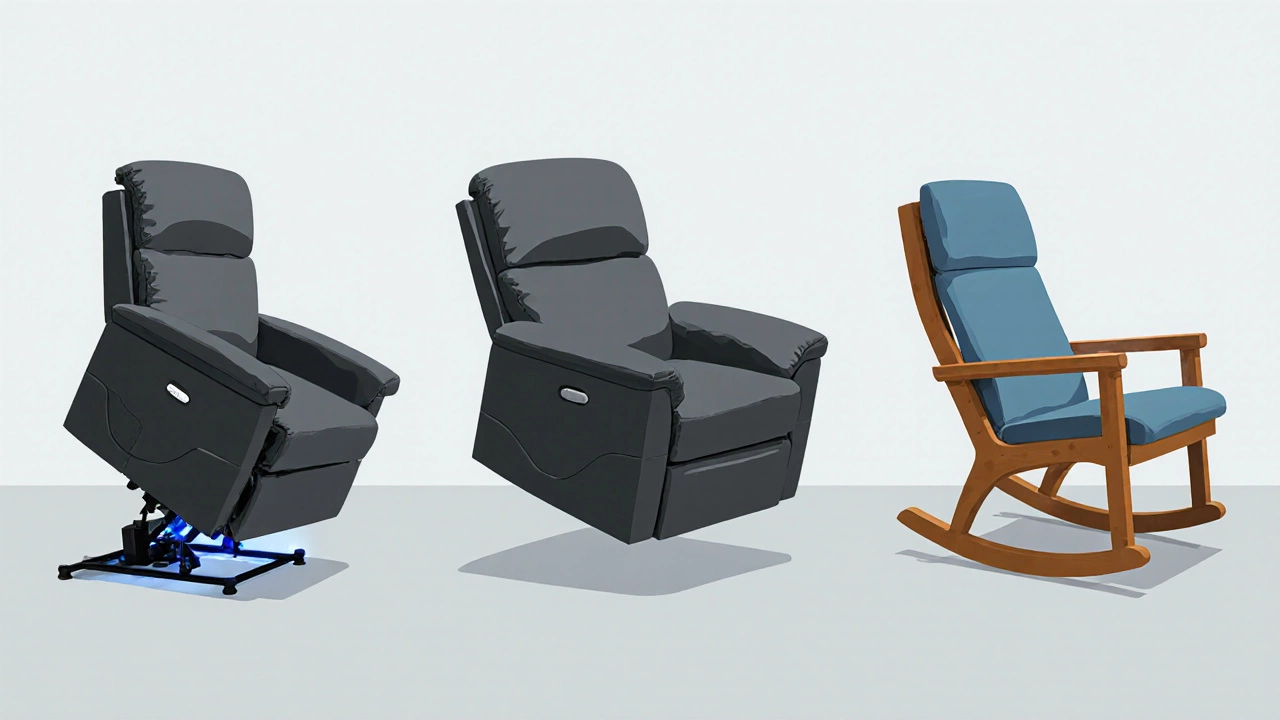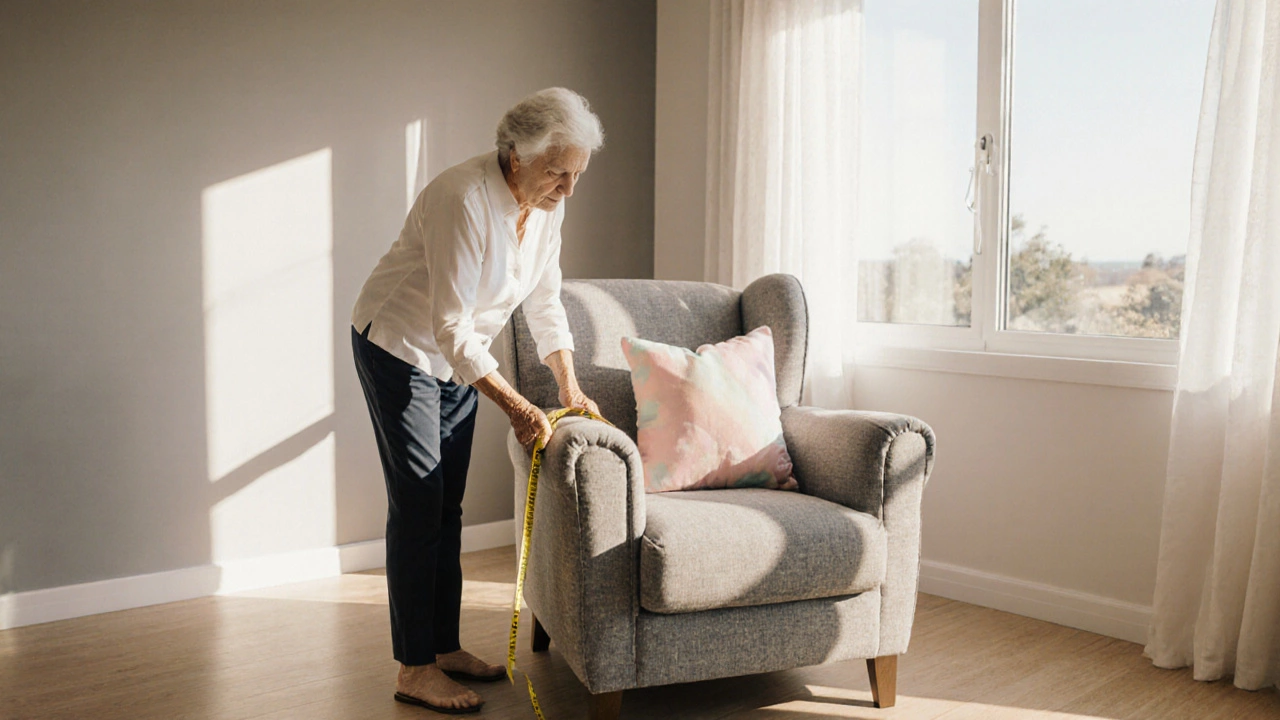Senior Chair Selector Calculator
Your Needs Assessment
Recommended Chair Type
Select your measurements and preferences above
We'll show your personalized recommendation
When talking about a Senior-friendly chair is a seat designed to meet the physical needs of older adults, offering easy entry, reliable support, and adjustable features that reduce strain when sitting or standing. Choosing the right one can mean the difference between daily comfort and frequent aches, especially for people over 65 who deal with reduced mobility, arthritis, or balance concerns. Below you’ll find a practical guide that walks you through the most important criteria, compares the top models on the market, and hands you a checklist you can use at the store or online.
Key Takeaways
- Seat height between 17‑19inches and sturdy armrests are non‑negotiable for safe transfers.
- Power‑assist lift mechanisms eliminate the need for users to push up with their hands.
- Fabric choice matters - breathable mesh or washable leather keep skin healthy.
- Weight capacity of at least 300lb ensures durability for most seniors.
- Never skip a hands‑on test; the chair should feel solid, smooth, and easy to adjust.
What Makes a Chair Senior‑Friendly?
Older adults face three main challenges when sitting: getting in, staying comfortable, and getting out without pain. The following features address each challenge directly.
- Seat Height & Depth: A height of 17‑19inches aligns with the natural standing position, reducing the effort needed to rise. Depth should allow the knees to bend at a 90‑degree angle, preventing pressure behind the knees.
- Armrests: Wide, padded armrests that are at least 9inches high give a firm lever for pushing up. Fixed armrests are best; swivel or removable ones can be confusing.
- Weight Capacity: Seniors often have additional weight from medical equipment or cushions. Look for a rating of 300lb or more. Weight capacity directly correlates with frame strength and longevity.
- Stability & Base: A five‑leg or wide‑base design with anti‑slip rubber feet prevents wobbling. Anti‑slip base is essential for carpeted or hardwood floors.
- Adjustability: Power‑lift, reclining, and tilt‑adjust functions should operate with a single button or lever. Motor‑assisted options remove the need for manual force.
- Ergonomic Design: Lumbar support and a contoured back reduce pressure on the spine. Ergonomic design is often highlighted in product specs.
- Fabric & Maintenance: Breathable mesh, antimicrobial upholstery, or leather that can be wiped clean keep skin healthy and simplify cleaning.

Top Chair Types for Seniors
Not every chair offers all the features above, but three categories hit the sweet spot for most older adults.
1. Lift Recliner (Power‑Assist Chair)
A lift recliner combines a motor‑driven lift with a reclining backrest. With the press of a button, the seat rises 2‑3inches, easing the transition from sitting to standing. Many models also include a zero‑gravity position that spreads weight evenly across the back and legs.
- Adjustability: Full‑range lift, multiple recline angles, and optional massage.
- Weight Capacity: Usually 300‑350lb.
- Price Range (2025 US): $800‑$1,800.
2. Standard Recliner with Power Tilt
This style offers a simpler motor that only tilts the backrest. It’s lighter and cheaper than a lift recliner but still provides a gentle recline for relaxation. Some models include a slide‑out footrest that can be extended without bending.
- Adjustability: Power tilt back, manual footrest.
- Weight Capacity: 250‑300lb.
- Price Range (2025 US): $500‑$1,200.
3. Rocking Chair with Ergonomic Support
A classic rocker can soothe aching joints with gentle motion. Modern ergonomic rockers feature a higher seat, built‑in lumbar curves, and sturdy armrests. They don’t have motorized features, making them a low‑maintenance option.
- Adjustability: Fixed rock angle; some offer lock‑in‑place.
- Weight Capacity: 250‑300lb.
- Price Range (2025 US): $300‑$800.
Side‑by‑Side Comparison
| Feature | Lift Recliner | Power‑Tilt Recliner | Ergonomic Rocker |
|---|---|---|---|
| Seat Height (in) | 17‑19 | 16‑18 | 18‑20 |
| Lift Mechanism | Yes (motor‑assist) | No | No |
| Recline Angles | 0°‑135° | 0°‑110° | Fixed |
| Weight Capacity (lb) | 300‑350 | 250‑300 | 250‑300 |
| Price (US$) | 800‑1,800 | 500‑1,200 | 300‑800 |
| Fabric Options | Leather, Microfiber, Mesh | Leather, Fabric | Wood, Upholstered |
Step‑by‑Step Guide to Picking the Right Chair
- Measure the user’s dimensions: Seat height, thigh length, and arm length. Write these numbers down.
- Identify mobility limitations: Does the person need a lift function? Can they manage a manual recline?
- Set a budget range: Include possible delivery and assembly fees.
- Test the chair in‑store or via a demo video: Sit down, push up, and try the recline. Feel the armrest width and back support.
- Check warranty and after‑sales service: Look for at least a 2‑year motor warranty and free first‑year maintenance.
- Compare final specs: Use the table above to see which model meets the most criteria.
- Place the order and arrange space: Ensure the room has clearance for recline or rocking motion (at least 3‑4ft of free space).

Maintenance & Safety Tips
Even the best senior chair can become a hazard if neglected.
- Inspect moving parts monthly: Listen for unusual noises that could indicate motor wear.
- Keep upholstery clean: Wipe leather with a damp cloth; vacuum fabric to remove dust that can irritate skin.
- Secure loose cords: Power cords should be clipped away from foot traffic to avoid trips.
- Check floor stability: If the chair wobbles, add a non‑slip mat or tighten the base screws.
- Follow weight limits: Over‑loading reduces the life of the motor and frame.
Real‑World Examples
Mary, 78, Melbourne lives alone and has mild arthritis. After trying a standard recliner, she found the backrest too hard and the armrests too low. A lift recliner with a 20‑inch seat height solved her problem - she can now rise with a single button press and enjoy movie nights without pain.
John, 82, Sydney prefers a gentle motion to calm his Parkinson’s tremors. An ergonomic rocker with a higher seat and sturdy wooden arms gave him both comfort and a soothing rhythm without any electronics to maintain.
Frequently Asked Questions
Frequently Asked Questions
Do lift chairs require a special power source?
Most lift chairs plug into a standard 120V outlet. Some models include battery backup for short power outages, but a regular wall socket is sufficient for daily use.
Can I use a lift recliner on carpet?
Yes, but place a non‑slip rug or a thin board under the base to prevent the chair from sinking into thick carpet fibers.
What fabric is best for seniors with sensitive skin?
Breathable mesh or antimicrobial microfiber are top choices. They allow air circulation and can be wiped clean, reducing the risk of skin irritation.
Is a higher price always better for senior chairs?
Not necessarily. Focus on the features you need - lift, weight capacity, and fabric - rather than brand prestige. A mid‑range model that checks all boxes often offers the best value.
How often should I service the motor in a lift chair?
Most manufacturers recommend a professional check‑up every 12‑18 months. Clean the motor housing and tighten any loose screws to keep performance smooth.
Choosing the best chair for seniors isn’t about picking the most expensive model; it’s about matching the user’s physical needs, lifestyle, and budget. Use the criteria, comparison table, and checklist above, and you’ll land on a seat that offers safety, comfort, and a little bit of joy every time you sit down.

